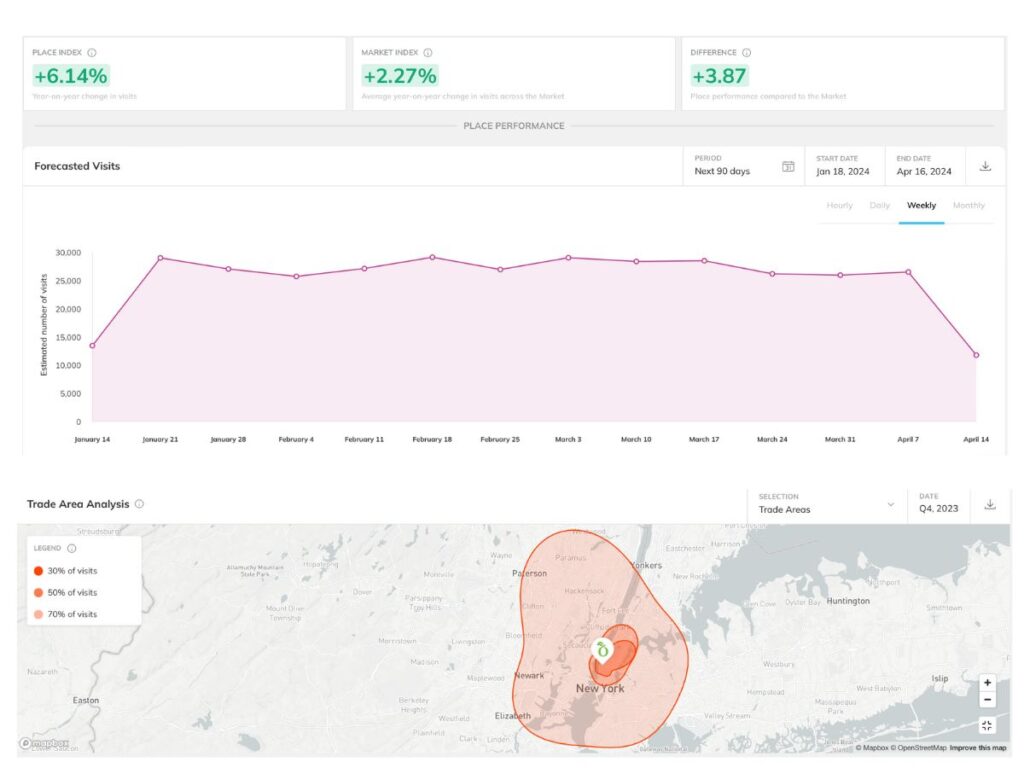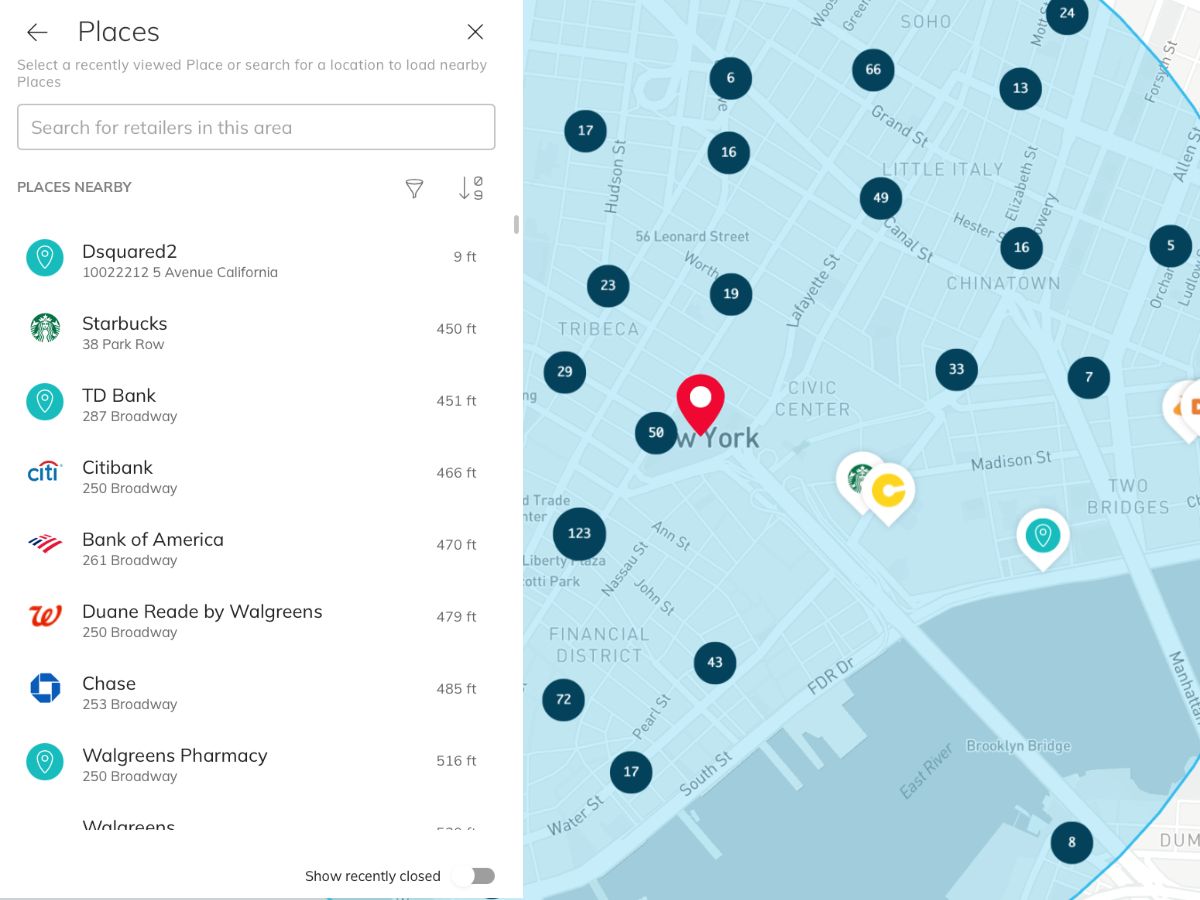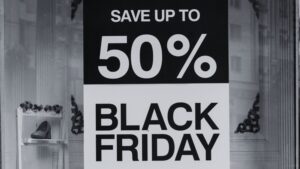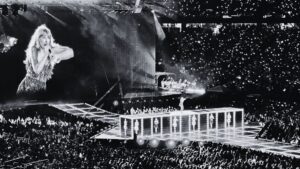All foot traffic data providers must measure foot traffic while complying with privacy laws by providing anonymized data without personal identifiers.
This type of data provides details such as income levels, transportation methods, education levels, and the number of visits to your store without revealing any personal information or violating privacy laws. Getting this data is imperative to increase foot traffic.
Anonymized data lets you stay within compliance while getting the data you need to improve retail operations, marketing campaigns, retail store design, and even making commercial real estate decisions.
Foot traffic data provider key points
- Foot traffic providers gather data using infrared sensors, Wi-Fi, Bluetooth, smartphones, manual counters, surveys, and video cameras.
- Measuring foot traffic is best done using multiple sources to ensure higher levels of accuracy.
- Data needs to be anonymized and aggregated to be compliant with privacy laws. Choose a provider with a good reputation and stringent validation methods to stay within compliance.
9 ways to measure foot traffic accurately
Foot traffic data providers gather information using foot sensors, manual counters, mobile devices, video cameras, mobility data, surveys, Bluetooth and Wi-Fi.
Methods that use manual counting take more effort and time, while methods using Wi-Fi or other technologies may have some accessibility or availability hurdles. To achieve the best and most accurate results, foot traffic counting methods are best used in combination.
Video cameras
Video camera systems can be used for foot traffic counting, usually after the day or an event is over as live counting using video cameras requires manual counting. One method is to use the video camera footage to take a sample and calculate foot traffic from there instead.
Camera systems are vital to maintain security and using them to count foot traffic can be an additional benefit, but this does make cameras one of the more expensive methods you can use. Additionally, collecting data in real-time is very difficult so you will need to wait for any actionable insights.
Video camera tips
- Get specific: Video cameras are often placed in important locations such as the entrance or indoor areas. For certain businesses such as retail, cameras can be used to measure the number of visitors within an important location.
- Combine with other methods: Best practice is to combine video cameras with another counting method, such as getting information from a foot traffic data provider.
Manual counters
Manual foot traffic counters are clickers that your employees press to count each visitor in a specific area. This method can offer specific traffic data in a certain area at a low cost, such as at an event or pop-up shop, but is prone to human error.
Manual counter tips
- Assign counters: Employees doing other tasks won’t be able to focus on purely counting visitors. Distractions and multitasking can get in the way, so have members of staff purely dedicated to using the counter.
- Control exit & entry points: If possible, limit the number of entry and exit areas. The more entrances, the more staff will be needed to count visitors.
- Log results: For regular updates, establish a schedule of logging clicker recordings (hourly, daily, etc) in a logbook or spreadsheet you can view.
Opt-in location tracking app
Using this method, visitors download your app and allow location tracking, providing more details about their movement within your location. This can result in detailed information such as rich data on roots taken and dwell times.
However, needing to download an app and opt-in to tracking means lower opt-in rates. You will also need to spend money on developing an app and maintaining it.
Opt-tin location tracking app tips
- Offer rewards: downloading your app should come with some incentives, such as a loyalty program, discounts, or exclusive offers.
- Privacy: Customers may have privacy concerns, which can limit the number of people opting into tracking. To overcome this, keep your app updated within compliance and make your policy easy to view.
Geofencing
A geofence is a virtual boundary around your location that uses GPS. When a device using GPS, such as a smartphone, enters the geofence area it triggers an event; for example, geofences can track the number of visits to your location.
Geofencing tips
- Place in an optimized location: The most common method of placing a geofence is to set it up around your business location. This can offer more specific and accurate tracking than others, but the amount of data foot traffic data providers provide using this method can be smaller than others.
- Place beacons indoors: Geofences are best used outdoors to monitor the entry and exit of an area. Beacons are how you keep track of movements indoors.
Beacons
Beacons are hardware sensors scattered throughout a location such as a retail store to gather information about visitor movements. Beacons use Bluetooth Low Energy (BLE) technology to use minimal power, at a slower speed than regular Bluetooth, to send you specific information.
The main challenges of using beacons for foot traffic are the installation and implementation stages. Initial installation can be expensive. Even once the beacons are fully set up, you will need visitors to have Bluetooth-connected devices to fully benefit from your new hardware.
Beacons tips
- Deployment: beacons should be strategically placed throughout your location, usually at entrances, exits, key product areas, and other areas of value.
- Start small: Consider starting a pilot program in specific locations to test strategies and analyze results.
Wi-Fi
Wi-Fi foot traffic counters work in a similar way to Bluetooth beacons. You detect Wi-Fi-enabled devices, indicating a visitor presence, and use a foot traffic data provider to analyze the results.
Wi-Fi can be preferable to Bluetooth methods as you may already have Wi-Fi installed at your property, so it has a faster implementation time-frame.
Wi-Fi tips
- Connection: Setting up free Wi-Fi can offer visitors an incentive to connect, which enables you to track devices. Non-connected devices will not be tracked, making this method more unreliable than others but still valuable.
- Get insights: Tracking numbers alone isn’t enough. Wi-Fi foot traffic counting offers detailed insights such as heat maps showing busy and quiet areas and can show you new and returning visitors.
Foot sensor pressure mats
Foot sensors are pressure mats embedded in the floor of a property to track visitor movements indoors. Unnoticed, these mats offer valuable insights into foot traffic patterns and visitor behavior.
Foot sensor pressure mats tips
- Place strategically: While pressure mats can be placed at the entrance of your property, they can also be placed at important conversion areas. For example, near the changing rooms of an apparel store or the checkout area.
- Count more than feet: Pressure mats can tell you more about the weight or pressure distribution. This can give an indication of how many adults or children are visiting or how many people are using shopping carts.
Infrared break beam sensors
Infrared sensors are invisible beams installed inside a property to track mobility events. The sensors are typically installed on either of a doorway to track the entrance and exit of visitors to a location.
The beams work by counting when the infrared beam is broken, which indicates someone has walked through it.
Infrared bream beam sensor tips
- False positives: Large objects or animals passing through the beams can be accidentally counted as visitors. No hardware is foolproof and this is one of the flaws you’ll need to work around by combining infrared with other technologies, such as pressure sensors or video cameras.
- Keep it clean: Infrared sensors need regular maintenance and calibration to ensure accurate results. Dust buildup or sensor misalignment can affect the results.
Thermal sensors
Unlike infrared sensors that rely on interrupted beams, thermal sensors take a different approach. They harness the power of heat detection to identify and track visitors based on their body temperature.
Every human emits heat, so their thermal signature will be picked up by the system of thermal cameras. These cameras don’t capture images or identify individuals–only heat signals–making them excellent for privacy.
Thermal sensor tips
- Crowds: Areas with big crowds can affect the accuracy of thermal sensors. In crowded areas, other foot traffic counters may be used at a higher accuracy to cover this weakness.
- Cost-benefit: Thermal sensors are more expensive than video cameras. Carefully analyze if thermal is the best choice for you before investing in a large system.
Surveys
Surveys can collect information from visitors, though getting enough visitors to fill out the form can be a challenge.
Surveys are also not as accurate as other methods but can offer details other methods can’t – such as the customer’s experience, visit intention, and any other feedback they have.
Survey tips:
Here are some methods you can use to increase the number of surveys completed:
- Train staff: Employees who interact with visitors should be aware of any active surveys, where to send customers to fill them out, and any potential rewards for a completed survey.
- Push online: Post on your social media pages, include a link on your website, and add a survey to emails when you can.
- Offer rewards: Completing a survey takes time and effort. If you offer a good reason for completing a survey, it makes it far more appealing such as a chance to win a product, prize money, or receiving a coupon code for a future purchase.
Examples of foot traffic data providers
The world of foot traffic data providers is diverse. Foot traffic data providers offer various solutions, some of which may be more suitable than others for your needs and budget.
The main types of data providers are app-based loyalty programs, data aggregators, hardware, and report providers.
pass_by
Pass_by is a geospatial foot traffic data and predictive analysis provider that uses more than 15 data sources. Adhering to ISO 27001 standards, pass_by offers aggregated and anonymized data backed by AI for retail, real estate, and finance.

Contact us today to learn more about the foot traffic data we provide and let us know how we can help you.
SMS Storetraffic app
SMS Storetraffic app is a compatible app for Storetraffic foot traffic counter devices. The app shows reports on the number of visitors in each of your locations, traffic analysis in generated reports, and other handy tools.
BlueFox
BlueFox is a data provider specializing in Wi-Fi solutions to measure real-time foot traffic. The provider measures the number of visitors, the dwell time, and other valuable information using Wi-Fi probes from visitor smartphones.
Stocard
Stocard is an app-based foot traffic data provider for retailers and customers. The app encourages shoppers to use the app for loyalty rewards and then provides retailers with insights on store visits and purchase patterns. Using a third-party app can give you a ready audience, and build loyalty, and is cheaper than developing your own store app. However, it does mean you have less control compared to having your own app.
Tips for choosing a foot traffic data provider
Navigating the sea of foot traffic data providers is tough. But you can land the ideal provider as long as you carefully consider your options. Here are some key tips to keep in mind:
Data quality
You need precise and accurate data to properly measure footfall. Not all data is made equal (and neither are providers!) Look for a provider with a track record of accuracy and transparency in their data collection and validation methods.
Privacy
As privacy laws continue to evolve, a provider that understands the importance of visitor privacy to protect your business is imperative. Choose a foot traffic data provider that complies with all relevant regulations. Ask about the data anonymity policies and question data sources.
Easy-to-use
Using a foot traffic provider with a poor reporting system or a system that requires a lot of training is going to cause you issues. The system should be straightforward to use, and offers reports and insights at the touch of a button.
Scalability
Does the provider offer flexibility as you grow? If a data provider only offers a limited solution such as only providing data from one or two sources, you may run into hurdles later on. Choose a provider that can adapt when your needs change.
Reputation and reviews
Take a look at any online reviews and get in touch with others in your industry. Case studies can also assist you. What’s the typical experience of those using this provider? Did they get help quickly if they ran into an issue? Take note of providers with a poor reputation or bad reviews.
Take advantage of demos and free trials
Don’t be afraid to experiment or compare! Use foot traffic data providers free trials, intro talks, demos, and videos to explore your options. After some time of using the product, don’t be shy about giving feedback as the provider may have a different option available more suited to you or work with you to improve your experience.
Foot traffic data FAQs
What are the ways to measure foot traffic in-store?
The ways to measure foot traffic in a retail store are a combination of Wi-Fi, beacons, Bluetooth, clickers, pressure sensors, infrared beams, surveys, and geofencing.
What is a foot traffic counter device?
A footfall counter device is a way of measuring and analyzing visits to a location. The devices can include manual counters such as clickers, video cameras, and pressure mats.
Where can I get consumer foot traffic data?
Use foot traffic data providers to receive consumer foot traffic data. There are many data providers available and each has its own sources, methods, and reporting tools. Book a call with our team to get data on your location, competitors, and industry.
What businesses need to track foot traffic?
All businesses that rely on visits for revenue need to track foot traffic. This includes brick-and-mortar clothing stores, restaurants, entertainment venues, supermarkets, and pharmacies.





